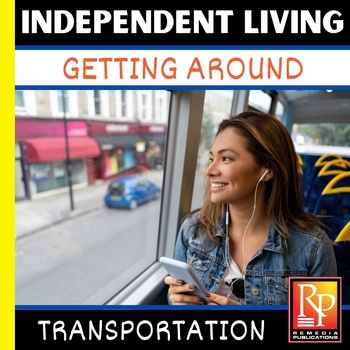INDEPENDENT LIVING- GETTING AROUND: Transportation, Cars, Subway, Bus Schedules
- PDF
Also included in
- Prepare your older students for independent living! All the worksheets and google slides you'll need to guide them through common “independent living” situations and offer easy-to-use information, suggestions, and advice. Activities follow each lesson and include practical application math and compPrice $90.66Original Price $120.84Save $30.18
- Prepare students for the real world! Essential lessons guide students through common “independent living” situations and offer easy-to-use information, suggestions, and advice. Great for Older Students! Activities follow each lesson and include practical application math and comprehension questPrice $52.90Original Price $59.94Save $7.04
- Here’s Your Ticket to Independent Living!Prepare students for the ‘real world’ with these important life-skills lessons! Getting Around town safely, affordably, and efficiently is your ticket to freedom, but it can also be a real-life challenge… These essential lessons feature helpful tips and imporPrice $15.95Original Price $19.98Save $4.03
Description
Here’s Your Ticket to Independent Living!
Prepare students for the ‘real world’ with these important life-skills lessons!
Getting Around town safely, affordably, and efficiently is your ticket to freedom, but it can also be a real-life challenge… These essential lessons feature helpful tips and important information about the joys and pitfalls of commuting by bike, bus, subway, and car.
Whether interpreting subway routes, bus schedules, calculating fares or buying and maintaining a car, students get tons of real-life-situation practice while also improving reading comprehension and practical application math skills.
Follow up activities include:
- Practical application math- distance, time, measurement, figuring miles per hour
- Basic comprehension questions to reinforce understanding.
- Some questions ask students to think about the the information given and to express their opinions and ideas.
- Key vocabulary activities feature a glossary of words and phrases students may not be familiar with plus activities to test understanding of the new words and phrases.
Topics Include:
Commuting by Bike:
- What are the Do’s and Don’ts of commuting by bike?
- Are there bike-friendly cities?
- How much less does it cost to commute by bike versus a car?
- Are electric bikes a good option?
- What are important bike-safety issues
- and more…
Commuting by Bus:
- Practice interpreting bus schedules & routes
- Determining how to get to your destination on time
- Are there bus-friendly cities?
- How much does riding a bus cost?
- Can a bus carry a wheelchair or a bike?
- Is it possible to travel long distance by bus?
- and more...
Commuting by Subway & Train:
- Practice interpreting schedules & routes
- Determining how to get to your destination on time
- Calculate train fares
- Purchase monthly passes
- and more…
Commuting by Car:
- How do car loans work?
- Buying vs leasing?
- Used cars vs new cars?
- Is car insurance really necessary?
- Car maintenance… is it that important?
- What are The Top 7 reasons for getting a traffic ticket?
- Tips for being a good & safe driver... even in bad weather!
Reading Level: Grades 3 - 4
Interest Level: Grades 8 - 12








